Intel Xeon W-2295 Benchmarks
For this exercise, we are using our legacy Linux-Bench scripts which help us see cross-platform “least common denominator” results we have been using for years as well as several results from our updated Linux-Bench2 scripts. We are going to show off a few results, and highlight a number of interesting data points in this article.
What we wanted to get a sense of is where the higher-frequency 18-core Xeon W part stacks up to its competition. As a result, we wanted to bring in AMD Threadripper and even an EPYC SKU. We also have the Xeon W-3275, Xeon E-2288G for top-of-the-line parts from other workstation ranges. We are bringing in our Core i9-10980XE numbers which is the desktop counterpart of this chip, and finally a selection of Intel Xeon CPUs. This review was done just prior to much of our Xeon Scalable Refresh testing. For some reference, the Intel Xeon Gold 6230 will perform more like the new Xeon Gold 5218R which is a $1273 part making it a legitimate competitor. Let us now get to results.
Python Linux 4.4.2 Kernel Compile Benchmark
This is one of the most requested benchmarks for STH over the past few years. The task was simple, we have a standard configuration file, the Linux 4.4.2 kernel from kernel.org, and make the standard auto-generated configuration utilizing every thread in the system. We are expressing results in terms of compiles per hour to make the results easier to read:
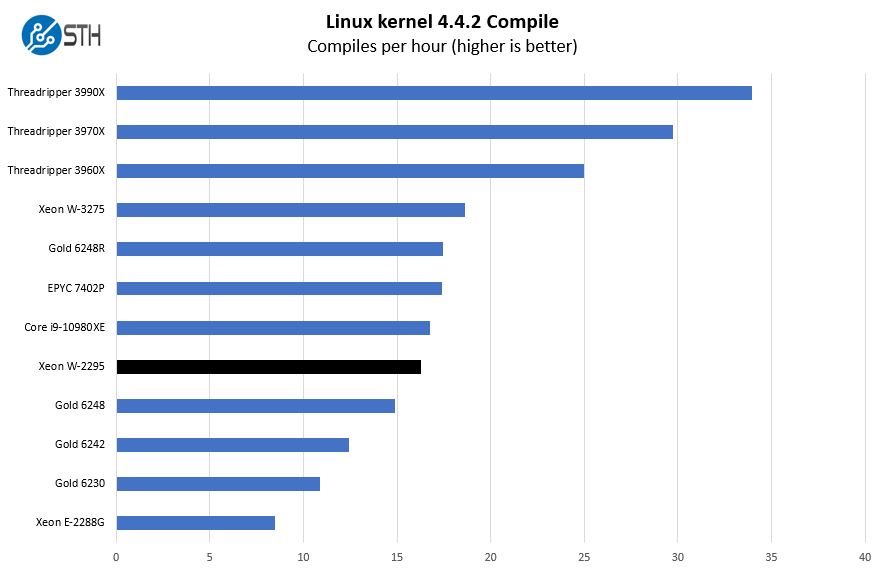
Here we can see trends start to emerge. At this point, we wanted to start with the Intel Xeon E-2288G comparison. This is an enormous performance jump of more than 2x over the entry-level Xeon top-end SKU. One also gets a significantly more robust platform with more PCIe as well as quad-channel memory support and ECC RDIMM support. While an Intel Xeon E-2288G platform tops out at 128GB of memory capacity, the Xeon W-2295 can hit 1TB or eight times the capacity.
c-ray 1.1 Performance
We have been using c-ray for our performance testing for years now. It is a ray tracing benchmark that is extremely popular to show differences in processors under multi-threaded workloads. We are going to use our 8K results which work well at this end of the performance spectrum.

Here we can see a case where the 18-core Xeon W-2295 can out-perform the more expensive Xeon Gold 6248 and Gold 6240 chips. Before the Xeon Scalable Refresh, the Xeon W-2295 was effectively giving single-socket performance per dollar figures that were 2x Xeon Gold CPUs.
7-zip Compression Performance
7-zip is a widely used compression/ decompression program that works cross-platform. We started using the program during our early days with Windows testing. It is now part of Linux-Bench.
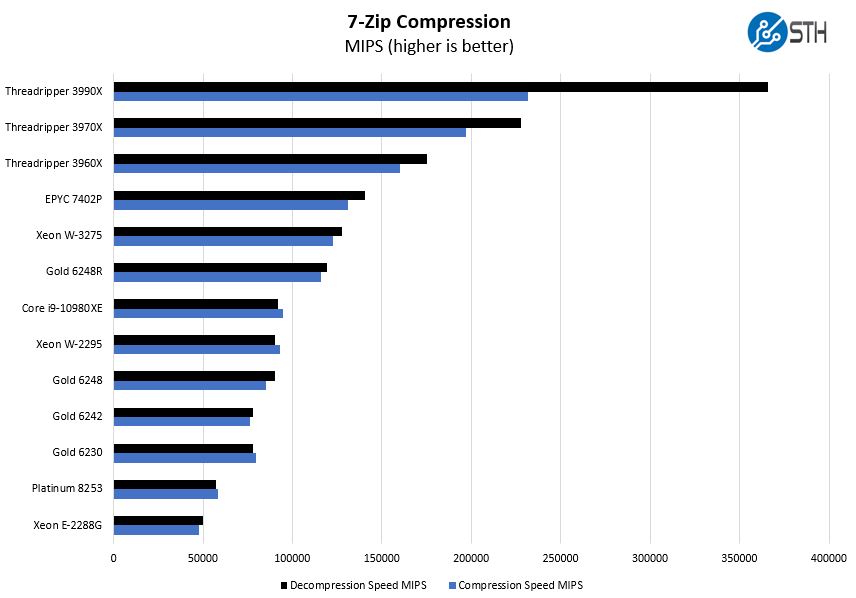
As you can see from these charts, the AMD Ryzen Threadripper parts are consistently much faster. AMD also has more PCIe lanes and they are PCIe Gen4 lanes. What AMD does not do is to support ECC RDIMMs on Threadripper platforms which means the Threadripper chips can support up to 256GB of memory while the Xeon W-2295 supports up to 1TB.
We will note that even the AMD Ryzen Threadripper 3960X at 24-cores is a much higher TDP part. Although the MSRP is only slightly higher, the Threadripper is a 280W TDP CPU while the Xeon W-2295 is a 165W TDP CPU. One can certainly get more performance, however, the trade-off is higher operational costs. This trade-off we are accustomed to seeing in the industry.
NAMD Performance
NAMD is a molecular modeling benchmark developed by the Theoretical and Computational Biophysics Group in the Beckman Institute for Advanced Science and Technology at the University of Illinois at Urbana-Champaign. More information on the benchmark can be found here. With GROMACS we have been working hard to support AVX-512 and AVX2 supporting AMD Zen architecture. Here are the comparison results for the legacy data set:
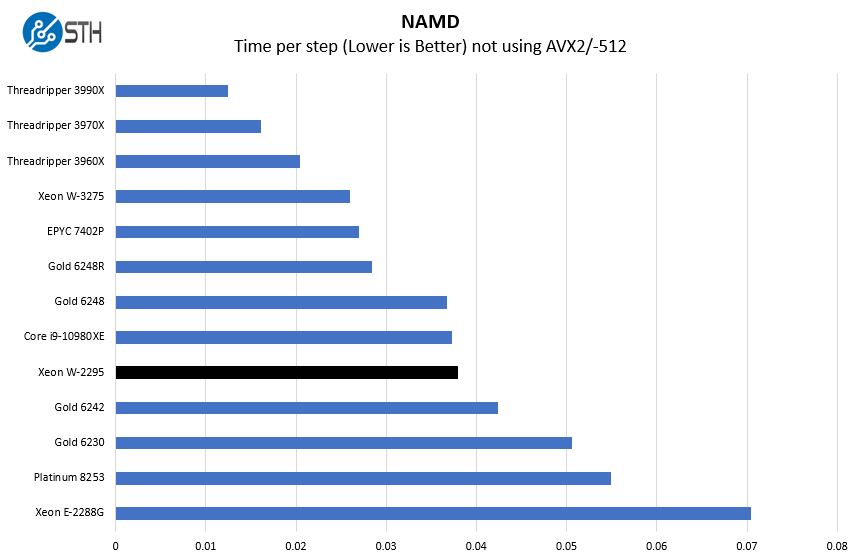
We wanted to quickly point out that the Xeon W-2295 is performing extremely well against the frequency optimized Xeon Gold 6242 processors which have lower core counts and higher clock speeds.
OpenSSL Performance
OpenSSL is widely used to secure communications between servers. This is an important protocol in many server stacks. We first look at our sign tests:
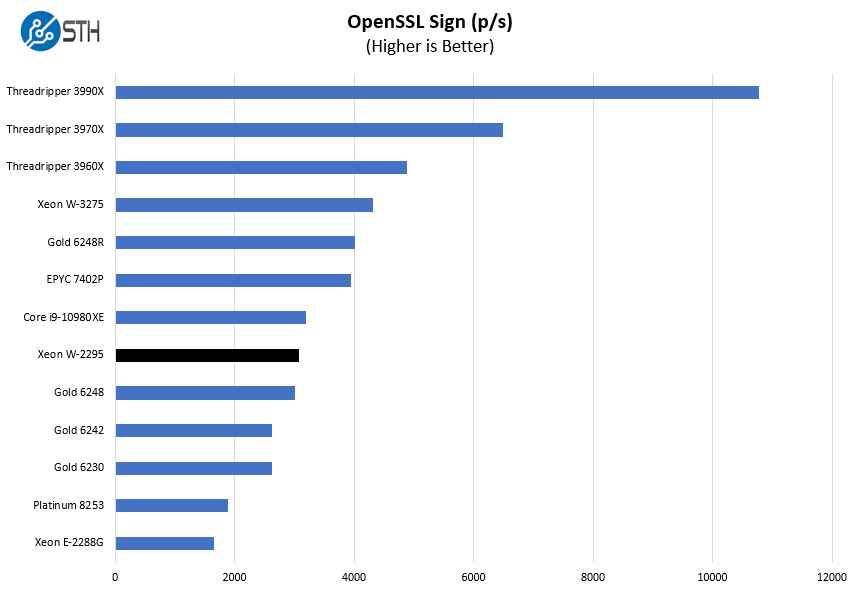
Here are the verify results:
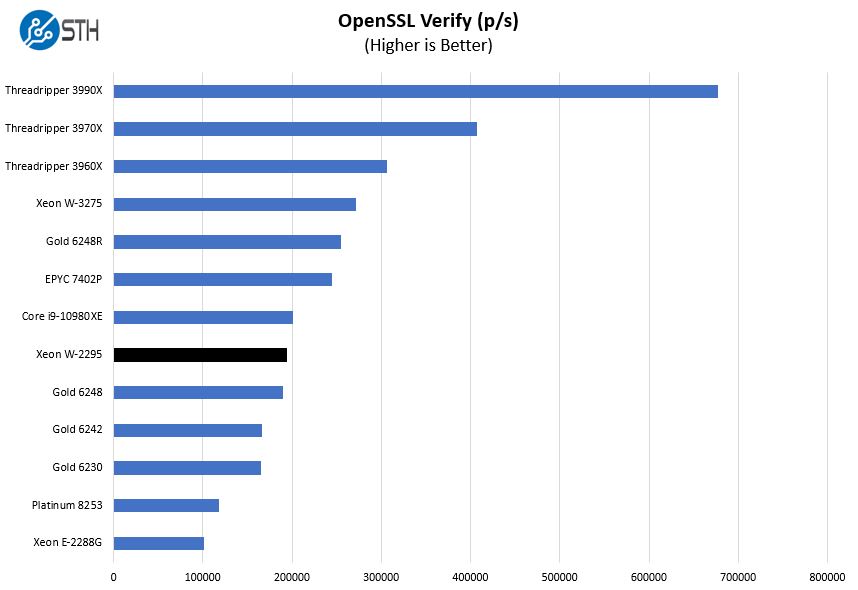
At this point, the trend should be fairly clear. We are seeing slight but consistently better performance from our Intel Core i9-10980XE sample at stock speeds which is not what we would have hypothesized. Effectively they are very close in terms of performance but the Core i9 is consistently slightly ahead. Our take is that the decision to get the Core i9-10980XE or the Xeon W-2295 will rest more on whether ECC memory and higher memory capacities are needed rather than performance. If one needs greater ECC memory capacity, then the Xeon W-2295 is the only option. If one does not need the feature, then the Core i9-10980XE makes a lot fo sense.
Given the closeness in results, if you want to see more workstation focused comparisons, you can see that Core i9 review for in-depth Windows perspective as well. We wanted to bring in some of the LGA3647 and EPYC Rome results so we are sticking with the Linux testing for this review.
UnixBench Dhrystone 2 and Whetstone Benchmarks
Some of the longest-running tests at STH are the venerable UnixBench 5.1.3 Dhrystone 2 and Whetstone results. They are certainly aging, however, we constantly get requests for them, and many angry notes when we leave them out. UnixBench is widely used so we are including it in this data set. Here are the Dhrystone 2 results:
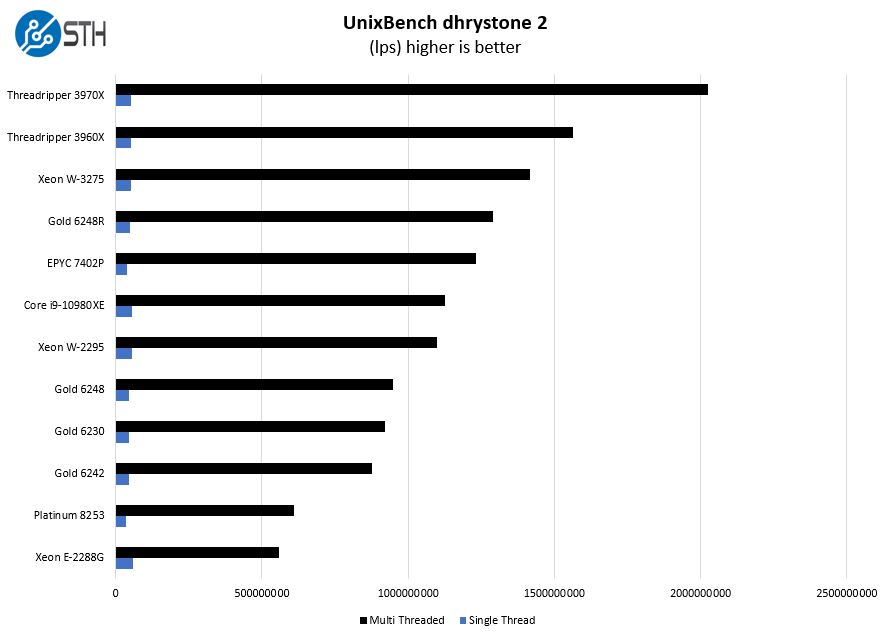
Here are the whetstone results:
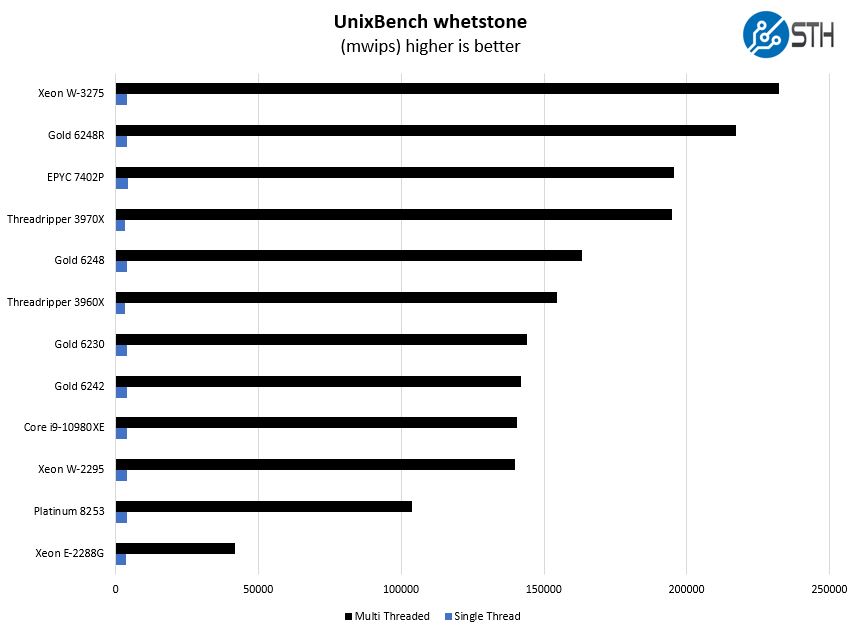
We pulled the AMD Ryzen Threadripper 3990X 64-core numbers out of this chart since they distorted the scale a bit. Also, that is a much higher cost part which is in a different product segment.
Chess Benchmarking
Chess is an interesting use case since it has almost unlimited complexity. Over the years, we have received a number of requests to bring back chess benchmarking. We have been profiling systems and are ready to start sharing results:
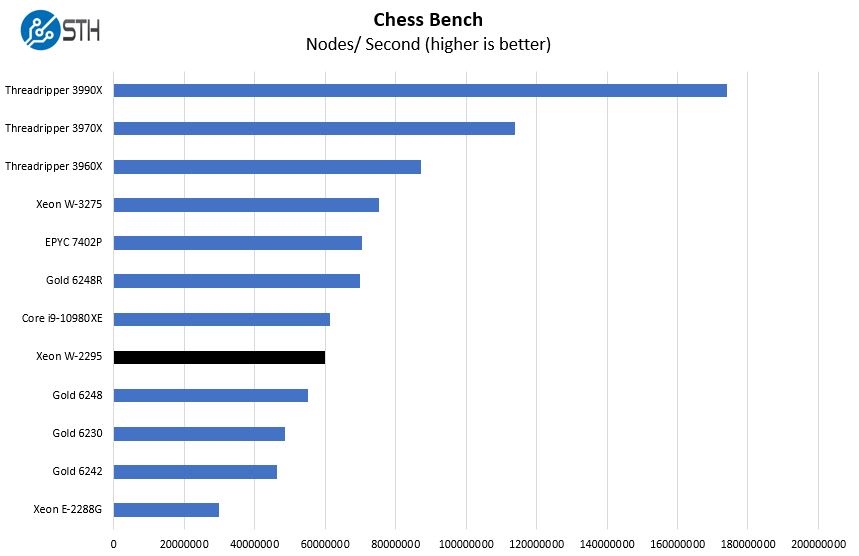
We wanted to quickly mention the AMD EPYC 7402P. That 24-core CPU features a much lower clock speed at up to 3.35GHz. What it has is 128x PCIe Gen4 lanes, 8x DDR4-3200 channels, and 128MB of L3 cache. One can make the case that one upgrades from the Xeon E-2288G to the Xeon W-2295 to get more cores and platform expandability. By that same token, the AMD EPYC 7402P can be a compelling offering.
On the power consumption side, it is very competitive with the Xeon W-2295. Along with a slightly lower list price, one can argue that it may even be a lower-cost solution than the Xeon W-2295.
GROMACS STH Small AVX2/ AVX-512 Enabled
We have a small GROMACS molecule simulation we previewed in the first AMD EPYC 7601 Linux benchmarks piece. We are not publishing results of the newer revision here since they are not compatible with our previous results.
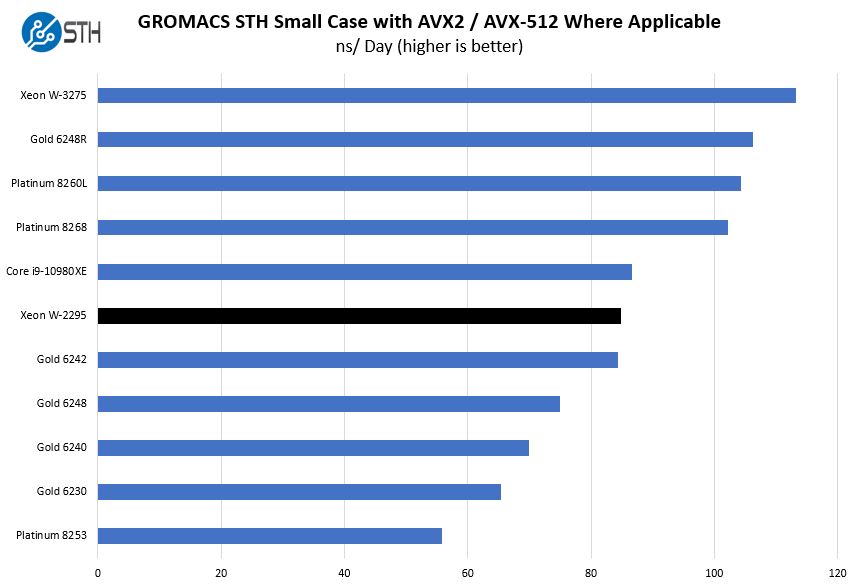
When we start pushing the AVX-512 pipeline, we can see the Intel Xeon W-2295 can actually compete with some of the Xeon Platinum 8200 series on a per-socket basis yet at a much lower cost.
Next, we are going to look at the Xeon W-2295 market positioning before moving to our final words.




Nice setup.
I would have been even nicer when the 3950x with a TDP of 105 Watt and the 3960x in ECO-MODE (~ 125 Watt and a performance decrease ~ 25%), would have been mentioned. It’s good to see that the competition between Intel and AMD brings us a lot, let’s hope we will see the same competition in the near future between NVidia and AMD (and all the ARM, RISC-V, etc.. processors).
Good busy times for STH and the community.
John, thanks a lot for this article. Was looking forward to be reading it for weeks already. Anyway, let me ask one question. You mention “For our 2nd Generation Intel Xeon Scalable CPU quad-socket reviews, we are using the following configuration:” — which looks like a template edit from some other article, which actually lead me to the question (if you have used different article as a basis): are you 100% sure about your power figures? I mean 131W OS idle is way much than what I would expect from the system. For example look into William’s article about i9-10980xe https://www.servethehome.com/intel-core-i9-10980xe-review-18-cores-of-pure-intel/6/ — idle power consumption is 71W! That’s something I would also expect from W-2295. So your 131W really surprises me a lot. Thanks for checking!
Also Misha’s comment brings up a good idea for a potential article – looking at the configurable TDP options of the threadripper chips (Should be noted that the IO die consumes a huge amount of power and this goes up as you use higher speed memory, so as you configure the TDP down, the all-core cpu performance discrepancy will rise.
Your conclusion is spot on. Intel needs this to be a $999 price part.
I don’t agree that the 3950X is a real competitor. It doesn’t have as many PCIe lanes. Gen4 is nice, but having more connectivity matters. I would’ve liked to have seen it in the review too, but I understand why it’s not there.
KarelG – That is what the number was. I agree it is higher but the test configurations are different so what can I say? We have a range of values here just to give some sense. At $0.20kWh power that’s $100 a year difference. I will gladly pay $100 a year more for components that are virtually silent. These are not sub $1000 systems so a higher idle load does not turn me off. I know that is simplistic, but the system itself was really nice even if idle power was higher than other configurations.
@Nate77
Same is valid for the Threadripper and the EPYC, they have more or way more PCIe lanes with way more bandwidth.
When looking at the test setup.
we are using the following configuration:
CPU: Intel Xeon W-2295
Motherboard: Asus WS C422 SAGE/10G
Ram: Crucial 128GB DDR4-2666 REG ECC (4x32GB)
Video Card: PNY GeForce RTX 2080 TI 11GB Blower Fan
Chassis: Fractal Design Define R6 USB-C Black
Power Supply: EVGA SuperNOVA 1000W P2 Power Supply
CPU Cooling: Corsair Hydro Series H60 CPU Cooler (Rev. 3)
It’s no problem to make a similar configuration with Ryzen, Threadripper or EPYC. STH has made enough side notes about the amount of memory, PCIe-lanes, etc.. and what you need when you want to do something with your setup.
John — thanks for confirmation. No offense, I’m just curious what the heck was that power hungry in the system in idle load since well, I cannot help, but still think CPU is not the culprit here.
Otherwise system was excellent and if I read your graphs right then even less consuming than W-2123 or a bit higher up to the 1950x territory and this is nice (graphs from Williams’ i9-10980xe article).
BTW: you have not mentioned drive(s) used in the configuration in the configuration paragraph, but I guess they don’t make that much difference…
Can you even buy the 10980xe anywhere? I see it listed for far higher prices than MSRP, comparable to this xeon, and it’s not even in stock then.
The product exists almost purely on Paper to make the Lineup look better to the shareholders.
If this xeon is actually available, that’s a huge step up for intel products.
Hi!i heard about the Intel xeon w-2295.it uses the lga socket2066. Mye pc has a lga socket2066. Can i upgrade to this processor?i have a I9-9900x processor.
Hi Farshad, you can upgrade to the 2295, however if you don’t absolutely need ECC, it would be wiser to wait until the 10980xe is back in stock, and if you don’t need AVX-512, AMD would be the smarter choice since they will provide an upgrade path over the next few years.
Great job, STH!
I do appreciate the work you are doing!
You are becoming one of my favorite site.
May I ask a wish?
I work in simulation field (FEA/CFD).
REQUEST
1) Could you run also the SPECworkstation benchmark as you did for 3960x/3970x/10980xe?
In particular, the Product Development.
2) Could you perform the benchmarks also with AVX-512 on? Just to see where this kind of instructions can influence the performance. Sometimes, Intel CPUs outperform AMD ones, even they have less core… Really interested in which cases (while waiting for Zen3 and their AVX-512 implementation).
Thanks
The missing link is the Linpack benchmarks – I can’t buy a Xeon workstation without seen the GFLOPS it can deliver.
BTW the W-2295 would have scored much closer to the 10980XE if 2933MT/s memory had been used. I discovered that it will continue to run at 2933MT/s with 2 DIMMs per channel if you use DDR4-3200R automatically derating to DDR4-2933R when loaded with 2DPC. The higher spec memory can then be leveraged at full-speed on a future W-3300 upgrade running 8 memory channels down the road.